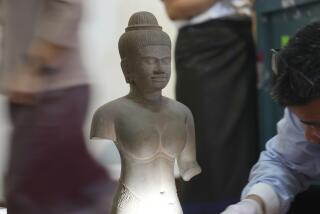Can Getty keep prized ‘Bronze’? Italy’s high court delays ruling
Italy’s highest court has once more delayed a ruling on whether it will affirm a lower court’s decision ordering the Getty Museum to return one of its most prized antiquities, the so-called Getty Bronze, to Italy after 36 years as one of the foremost works on display at the Getty Villa in Malibu.
A panel of judges for a branch of the Court of Cassation took up the case on Wednesday in a closed session and had been expected to issue a ruling Thursday, but Getty spokeswoman Julie Jaskol said that it had received word that the court had now deferred its ruling until June 4.
The saga of the nearly life-size statue, also known as “Victorious Youth,” is approaching the 50-year mark, unless you want to go back more than 2,300 years to the 300s BC, when it’s believed to have been forged by Lysippus, personal sculptor to Alexander the Great.
Fishermen from the Italian port of Fano hauled it out of waters off Italy’s Adriatic coast in August 1964, according to the Getty’s research -- and they were about 35 miles offshore, in international waters well beyond Italy’s maritime territorial limit.
The fishermen subsequently broke Italian laws by hiding the statue instead of reporting the find to authorities; dealers who later acquired it broke Italian law once more by exporting it without the required government license. The Getty’s top attorney, Stephen Clark, says other owners had it in London and Germany before the Getty Trust bought “Victorious Youth” in 1977 for today’s equivalent of $15.4 million.
Italian courts have ruled several times in the past that there are no grounds for declaring the statue Italian property under a 1939 law that says all cultural works found in Italy’s territory belong to the state.
But legal and political authorities in the Marche region, which includes Fano, persisted in recent years, winning lower court rulings in 2010 and 2012 that ordered the Getty to hand over “Victorious Youth.” The Getty appealed, and it’s now up to the national high court whether to affirm or overturn the decision that the Bronze belongs to Italy.
Some outside experts on art law and the repatriation of looted art think the Getty is on solid ground, that Italy has no claim to the statue because it wasn’t found in Italian waters or on Italian soil -- and if any nation had a claim it would be Greece, where it was created and whose cultural patrimony it truly represents. The most advanced art and culture in Italy in the 300s BC was not Roman, which was still centuries from its prime, but that of Greek visitors and colonists.
But there’s also a school of thought that museums should avoid holding on to objects that have any legal taint -- and that the Getty Bronze is too tarnished to keep because it was hidden, then exported without a permit, albeit before J. Paul Getty began eyeing a purchase in the 1970s.
Italian courts mulled those issues years ago and brought no charges, and the Getty’s Clark says that, in any case, the proper penalties would have been fines, not seizure and expropriation of a statue to which Italy has no valid claim.
If the ruling goes against the Getty this time, it will have to consider whether defying the order would undermine the good relations, including prized loans of Italian art, that it has enjoyed with the Italian government’s culture ministry. A precondition for the nearly seven years of goodwill was the Getty’s return starting in 2006 of dozens of artworks, including some of its best antiquities, all of which bore evidence of having been looted from Italian turf.
But if the fragile Bronze goes back to Italy, might the Greek government, whose excellent relations with the Getty are reflected in a major current exhibition at the Getty Villa on Byzantine art from Greek national collections, then deliver its own demand to Rome for the return of what clearly is a brilliant piece of Greece’s cultural patrimony?
Stay tuned.
More to Read
The biggest entertainment stories
Get our big stories about Hollywood, film, television, music, arts, culture and more right in your inbox as soon as they publish.
You may occasionally receive promotional content from the Los Angeles Times.







